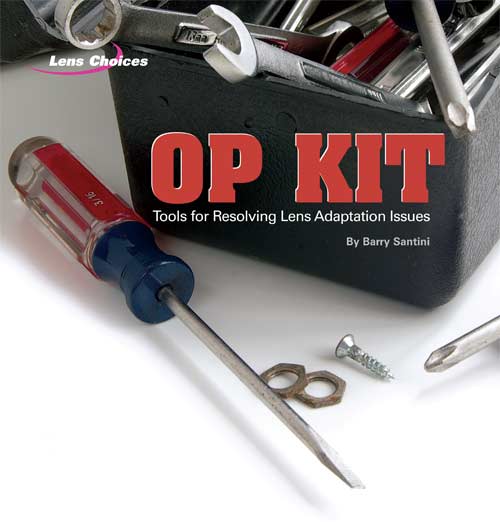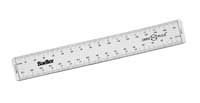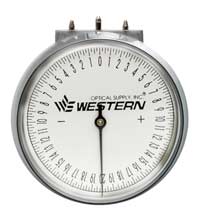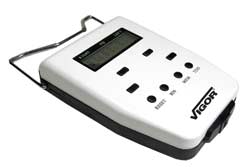
From an ECP’s point of view, it seems that the process of helping people to select eyewear often falls into one of two categories: easy or hard. Whether it’s frame or lens selection, measuring and fitting, fashion and appearance, or cost and insurance, it quickly becomes apparent if things are going the easy way or the hard way. But if your patient returns within a few days of initial delivery, it often means there will be problems requiring attention, a.k.a. “the hard way.” If the reason for returning is related to lens adaptation issues, it also means spending time—often lots of it—to investigate the possible causes. From a pure dollars and cents standpoint, the time spent here is monetarily unrewarded.
To reduce and save this extra time, some dispensers find simply referring them back to the prescribing doctor very attractive. But, if a dispenser masters how to methodically and efficiently uncover the root causes of adaptation issues, an intangible and priceless treasure awaits: the trust of the patient.
Listening Between the Lines: a Case History
Every attentive and competent dispenser strives to be a good listener and interpreter of what their clients say about their eyewear before, during and after the sale. When a problem is presented, it is often wise to not take literally everything a client offers up about their complaint. To illustrate, let’s look in depth at a sample adaptation issue I had to recently work through: A regular client came in to have his new refraction filled and he intended to select a few pairs of eyewear.
History
Adam, a 53-year-old lawyer, a strong myope (-9.50D) and a presbyope (+2.00 add). Although he is currently wearing progressives made by me, he had previously demonstrated timidity about any type of change in Rx, frame style (moderately sized, rectangular plastic) or lens material (standard plastic & 1.60 index). His sunglasses are simple, tinted standard plastic lenses.
Expectation
His new Rx changed decreased by approximately 0.50D, with the same +2.00 add. He indicated he thought he “needed” a change, as both his distance and near vision were not as “sharp” as he liked.
Selection
Although previously hesitant about change, Adam was accompanied for the first time by his wife, who encouraged him to “make a change.” We selected a narrower, rectangular metal frame, into which I placed a significantly higher index (1.74) progressive lenses with a reduced fitting corridor of 17mm (previous height: 19mm). Additionally, he desired new sunglasses. I made a bold proposal and placed a sport-styled, carbon-fiber look, chunky plastic frame, featuring an 11 degree panoramic (a.k.a., face-form or frame wrap) angle. He took an immediately liking to the novelty of this sun-style frame, but was nervous about the “change.” I then suggested a moderate-style, rectangular metal, with a panorama angle of 10 degrees. With some encouragement and enthusiasm from his wife, he opted to purchase both pairs of sunwear—to have, what he said was “a choice.” Both sunwear pairs were made with 1.67 index polarized lenses, in a G-15 (greenish-gray) color, with backside-only AR.
Lab and Fabrication
I choose a digitally iterated, free-form optimized progressive (this was the first time for Adam had eyewear with an AR finish) for the “clear” pair (zero wrap angle). For the sunwear, in consideration of the Rx and wrap angles of the frames, I also selected a digitally iterated progressives, computed using the respective wrap angles (but no vertex distance adjustment). The 1.74 clear pair had a POV (Position of Wear*) adjustment made in the Rx parameters. For the sunwear, I targeted base curves of 2.75D as a as a best compromise for the wrap angles involved (the clear pair, it should be noted, was made with a 0.50D base curve). Preliminary calculations for the sunwear revealed an additional power decrease of 0.37D in the sphere powers, with a slight astigmatism due to the wrap angle. In view of the original Rx reduction, I elected to not compensate the sun sphere powers, but I did add in the astigmatism adjustment.
Delivery
This went surprisingly well, considering his previous reticence for change. All three pairs were quickly dispensed and Adam seemed happy and comfortable. (Whew!)
Complaint
A few weeks later, Adam came in to get his eyewear adjusted. The clear pair was working fine and he received many compliments on his new style. His sunwear simply needed snugging up and nothing was said about any perceived problems. A week later, Adam called to say that he felt that his plastic-framed sunwear appeared, in his own words, “fuzzy.” Subsequent inspection of the lenses did not reveal any flaws or coating issues. An adjustment was made (reducing the wrap angle slightly, to eight degrees). Ten days later Adam called and said his sunwear was still fuzzy, and I ask him to come in and discuss it in person. At this point, he raised the cost issue and pressed why such expensive eyewear was not working like his previous pairs made by me. (The seeds of doubt have been planted.) I started to question if I had, perhaps, taken his optical correction too far with mild-wrap lens technology and prescription compensation.
Eureka! Case Solved
An in-person discussion has the potential to always reveal more than any telephone or email communication. While Adam was re-describing his sunwear’s “fuzziness,” his casually also mentioned the word “shadows.” Although he was mentioning this against as seen against the sky, I offered up the question “Do you also see this same shadowing on the side and/or back windows of cars?” “Yes,” he replied. We then reviewed how his new sunwear represents his first polarizing lenses, and that this “shadowing” effect is normal. After this discussion, everything became “OK,” since he felt confidently reassured that what he was experiencing was normal. Trust regained.
Every attentive and competent dispenser strives to be a good listener and interpreter of what their clients say about their eyewear before, during and after the sale. When a problem is presented, it is often wise to not take literally everything a client offers up about their complaint. To illustrate, let’s look in depth at a sample adaptation issue I had to recently work through: A regular client came in to have his new refraction filled and he intended to select a few pairs of eyewear.
History
Adam, a 53-year-old lawyer, a strong myope (-9.50D) and a presbyope (+2.00 add). Although he is currently wearing progressives made by me, he had previously demonstrated timidity about any type of change in Rx, frame style (moderately sized, rectangular plastic) or lens material (standard plastic & 1.60 index). His sunglasses are simple, tinted standard plastic lenses.
Expectation
His new Rx changed decreased by approximately 0.50D, with the same +2.00 add. He indicated he thought he “needed” a change, as both his distance and near vision were not as “sharp” as he liked.
Selection
Although previously hesitant about change, Adam was accompanied for the first time by his wife, who encouraged him to “make a change.” We selected a narrower, rectangular metal frame, into which I placed a significantly higher index (1.74) progressive lenses with a reduced fitting corridor of 17mm (previous height: 19mm). Additionally, he desired new sunglasses. I made a bold proposal and placed a sport-styled, carbon-fiber look, chunky plastic frame, featuring an 11 degree panoramic (a.k.a., face-form or frame wrap) angle. He took an immediately liking to the novelty of this sun-style frame, but was nervous about the “change.” I then suggested a moderate-style, rectangular metal, with a panorama angle of 10 degrees. With some encouragement and enthusiasm from his wife, he opted to purchase both pairs of sunwear—to have, what he said was “a choice.” Both sunwear pairs were made with 1.67 index polarized lenses, in a G-15 (greenish-gray) color, with backside-only AR.
Lab and Fabrication
I choose a digitally iterated, free-form optimized progressive (this was the first time for Adam had eyewear with an AR finish) for the “clear” pair (zero wrap angle). For the sunwear, in consideration of the Rx and wrap angles of the frames, I also selected a digitally iterated progressives, computed using the respective wrap angles (but no vertex distance adjustment). The 1.74 clear pair had a POV (Position of Wear*) adjustment made in the Rx parameters. For the sunwear, I targeted base curves of 2.75D as a as a best compromise for the wrap angles involved (the clear pair, it should be noted, was made with a 0.50D base curve). Preliminary calculations for the sunwear revealed an additional power decrease of 0.37D in the sphere powers, with a slight astigmatism due to the wrap angle. In view of the original Rx reduction, I elected to not compensate the sun sphere powers, but I did add in the astigmatism adjustment.
Delivery
This went surprisingly well, considering his previous reticence for change. All three pairs were quickly dispensed and Adam seemed happy and comfortable. (Whew!)
Complaint
A few weeks later, Adam came in to get his eyewear adjusted. The clear pair was working fine and he received many compliments on his new style. His sunwear simply needed snugging up and nothing was said about any perceived problems. A week later, Adam called to say that he felt that his plastic-framed sunwear appeared, in his own words, “fuzzy.” Subsequent inspection of the lenses did not reveal any flaws or coating issues. An adjustment was made (reducing the wrap angle slightly, to eight degrees). Ten days later Adam called and said his sunwear was still fuzzy, and I ask him to come in and discuss it in person. At this point, he raised the cost issue and pressed why such expensive eyewear was not working like his previous pairs made by me. (The seeds of doubt have been planted.) I started to question if I had, perhaps, taken his optical correction too far with mild-wrap lens technology and prescription compensation.
Eureka! Case Solved
An in-person discussion has the potential to always reveal more than any telephone or email communication. While Adam was re-describing his sunwear’s “fuzziness,” his casually also mentioned the word “shadows.” Although he was mentioning this against as seen against the sky, I offered up the question “Do you also see this same shadowing on the side and/or back windows of cars?” “Yes,” he replied. We then reviewed how his new sunwear represents his first polarizing lenses, and that this “shadowing” effect is normal. After this discussion, everything became “OK,” since he felt confidently reassured that what he was experiencing was normal. Trust regained.
—Barry Santini
How Lens Adaptation Problems Originate
The ingredients that make up lens adaptation problems are manifold. They range from evolution’s influence on our visual and perceptual development, all the way to a lack of awareness on the part of otherwise experienced ECPs about their own habitual, error-prone measurement techniques. Throw in eyewear prescriptions influenced by the combination of the flawed geometry of today’s 10-foot, folded exam room, human transcription errors and doctor’s discretion, it’s a wonder so many people find their new eyewear as visually satisfying as they do. While the list of factors cited below is far from comprehensive, it is meant to help dispensers understand and tackle specific lens adaptation problems. Further, it is also hoped that dispensers will use this information constantly to challenge themselves to develop their own skill set capable of solving any adaptation problem they encounter.
Why Are Humans So Sensitive To Change?
The keys to resolving adaptation issues lie in both understanding how human vision has evolved, along the sensory concept of habitual vision. Millennia ago, our ancestors had very primitive brains. As their senses evolved (including sight), nature made the best and most efficient use of our limited cranial power by favoring sensory processing that focused on changes in stimuli rather than attempting to process the total sensory stream. Through natural selection, we evolved to become creatures acutely well suited to making comparisons about what our senses tell us. In particular, evolution has endowed our peripheral vision to be very sensitive to change. For our ancestors, the simple flicker of a blade of grass in our periphery could mean either food or a predator. Recognizing either of these possibilities was essential to survival. Our vision, which is said to deliver 90 percent of the information we use, is sensitive to change because our survival has been dependent on it.
 World’s Best
Image Processor
World’s Best
Image Processor
The human eye has been described as the world’s best image processor. But what does this statement really mean? Besides the simple optical light-refracting elements of our cornea and lens, there is evidence that incoming photons are first subjected to complex processing within parts of the light-sensitive retina itself. Further, as visual sensory data travels onto the cortex of the brain, it is now known that a few stops and processing detours takes place along the way. The final processing subsequently occurs in the occipital cortex. The totality of our visual experience, i.e. “the human eye,” is the sum of simple refraction and this multi-level processing.
Contrary to a camera, our eye is not only concerned with simple, photonic signal levels. Instead, it has become an exquisite detector of contrast. It is constantly in search of ever greater levels of image contrast. And where vision contrast is not optimal, as for example, when someone doesn’t habitually wear their mild correction, or continues to wear a prescription that is not optimized or up to date, our brains will attempt to create satisfactory levels through subtle and complex inferred enhancements (not unlike when you see people on “CSI” refocus a blurred license plate or face). These situations, especially if sustained over time, will result in the inferred contrast becoming a new baseline for making visual comparisons. When the occasional or updated pair of eyewear is subsequently donned, retinal image contrast levels will spike. The sensations created can be overwhelming and are often subjectively described as “hurting” or “too bright.” (Note: high levels of image contrast are often confused with and incorrectly described as “brighter.”)
Rather than a static process, human vision is fundamentally dynamic in nature. We are constantly comparing what we see with what we know. Changes are noted and flagged for attention by our conscious mind. The perceived impact of these changes will vary from individual to individual. With respect to eyewear, they can occasionally get further mixed-up with factors such as frame comfort, fit and appearance. Your task is to separate the optically unrelated influences and uncover what is bringing your client to the point of complaint.
In the Eye of the Beholder
We humans seem to take our vision for granted more than any other sense. Because of this fact, any changes introduced to a client’s habitual vision by new eyewear will require them to “get used to it.” So when eyeglass wearers speak about how they dread the process of getting new eyewear, they are really referencing the peripheral or perceptual adjustments these changes require of them. It’s no wonder people approach a new prescription as if it carried a sign above that said: “Danger: change lies ahead!” To better understand what comprises this experience; let’s explore the ophthalmic factors that influence people’s visual perception.
 Changes in Peripheral Vision
Changes in Peripheral Vision
Anything that alters our peripheral vision has been flagged for attention by evolution. Changes made in power, astigmatism, material index, base curve (often driven by changes in index) and lens design, i.e., aspheric and/or progressive, will impact peripheral vision. Additionally, frame shape, size and tilt (pantoscopic and wrap) also influence peripheral vision. As adults, we’ve allowed the normal, single-vision prescription and frame style changes we’ve experienced to be placed into our personal hopper of habitual vision experiences. It’s not surprising then that just about every prospective progressive wearer retells not the success stories of others, but rather the trouble they’ve heard about getting used to progressives. The stories of these troubles then go on to become legends. One thing you are sure of is that everyone will notice the difference in visual acuity between straight-ahead and peripheral gazes. This type comparative of difference separates the progressive lens experience from that of all other lenses.
Posture, Preference and Multifocals
Trying to ascertain in advance the postural habits for a new multifocal client is like trying to determine what you’ll find at the beginning of an archeological dig. Surprises and pitfalls lurk around every corner. Below is a short list of things to remember:
- Shorter people will tilt their heads back
- Taller people will look downward more
- Everyone tends to tilt their heads back while being attentive when driving
- Everyone will initially resist or misinterpret the instruction to “tilt their head forward” when addressing stairs and steps
Don’t Be Condemned To Repeat History
 The importance of always recording
a client’s “previously worn” history cannot be overstated. When trying to solve an adaptation problem, record the basic Rx parameters for all the eyewear they have. Also record base curves, prism (PDs), pupil height and the overall condition of the lenses and frames (indicates care). With respect to pupil heights, be sure to record the following criteria for each lens design:
The importance of always recording
a client’s “previously worn” history cannot be overstated. When trying to solve an adaptation problem, record the basic Rx parameters for all the eyewear they have. Also record base curves, prism (PDs), pupil height and the overall condition of the lenses and frames (indicates care). With respect to pupil heights, be sure to record the following criteria for each lens design:
- Single-Vision: Note distance from center of pupil to both MRP and optical center
- Bifocal/Trifocal: Note distance from pupil center to top of segment line
- Progressive: Note distance from pupil center to that design’s fitting cross
The Personal Aspects of Fitting and Measuring
Frame styling, design, size, shape and fit are subject to the same sensitivity-to-change phenomena that have been linked above to prescription lens factors. Be aware that changes in temple width or placement, the introduction of rimless attachment points or a change in the thickness, color, reflectivity or proximity of the frame eye wire can affect or be mixed by clients into overall lens adaptation problems.
Be on guard about becoming complacent regarding your measurement-taking techniques. Each of us, as well as our clients, has a well-developed retinue of postural habits that may impact the accuracy and determination of representative measurements. For instance, small head tilt variations from the baseline, perpendicular facial plane can dramatically impact height measurements. Maintaining an accuracy of 1mm for height measurements is no small task.
The task of taking measurements to standards of uniformity and repeatability should be mandatory for all office dispensers. Try having an office clinic, wherein each dispenser obtains their own basic values for PD, height and temple length for one individual and then compare all the measurement values. Everyone should then help analyze why some dispenser’s values are significantly different than others. Improved awareness about the factors that influence obtaining repeatable measurements will develop among all dispensers.

Be Proactive About Lens Adaptation Issues
Solving lens adaptation problems is a challenging and dynamic process. Everything learned from helping one client can be used to more efficiently help others. The time spent in sleuthing pays two dividends: First, the trust and loyalty of your client are retained, which is good for business. Second, the experience gained over time helps to arm the dispenser with the tools to be proactive about preventing problems in the future. Those ECPs who make the effort become the true “master opticians.”
Barry Santini is a New York State licensed optician based in Seaford, N.Y.











